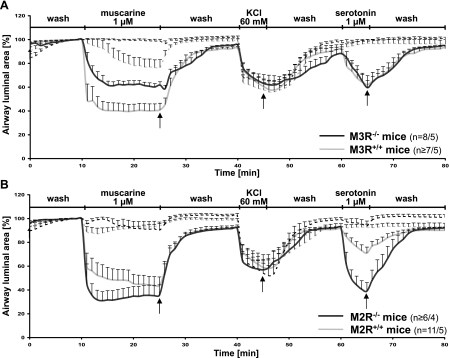Fig. 6.
Bronchoconstrictor responses of M3R−/− and M3R+/+ mice (A) of M2R−/− and M2R+/+ mice (B) to stimulation with muscarine (1 μM), KCl (60 mM), and 5-HT (1 μM) after vehicle (—) or MCD treatment (- - -). Data represent luminal area with prestimulus value set as 100%. A: caveolae disruption reduces the response to muscarine in bronchi from M3R+/+ mice and fully abrogated in M3R−/− mice. No differences in response to KCl occur after MCD or vehicle treatment in either mouse strain. 5-HT-induced responses are fully abrogated by MCD in both strains. B: in M2R−/− and M2R+/+ mice, the muscarine-induced constriction is not significantly different from M2R+/+ mice and is reduced to less than 10% after MCD treatment. No differences in response to KCl occurred after MCD or vehicle treatment in either mouse strain. Responses to 5-HT were less distinct in M2R+/+ compared with M2R−/− mice but were reduced after caveolae disruption in both strains. Data are presented as means ± SE; n = number of bronchi/animals.

